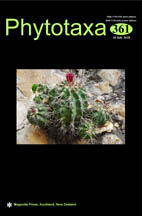Abstract
Centaurea masjedsoleymanensis endemic to SW Iran and C. palanganensis endemic to W Iran are described as new species and illustrated. Centaurea masjedsoleymanensis is distinguished from its closely related species, C. pabotii, by having shorter median and upper cauline leaves, a spine of phyllaries up to 4 mm long, incised median cauline leaves, and smaller upper cauline leaves. Centaurea palanganensis is distinguished from C. thracica by having decurrent median cauline leaves, oblong or elliptic basal cauline leaves, phyllaries with a median appendage 10–13 mm long and a spine up to 2 mm long. The IUCN conservation status of both new species is evaluated as Vulnerable (VU). Results from cytogenetic analyses indicated that new taxa are diploid (2n = 2x = 16), which is consistent with the proposed base number of x = 8 for the genus. Meiosis was observed as regular, with bivalent pairing and normal chromosome segregation. Based on the results x = 8 and 9 was determined for C. sect. Microlophus. The relationships between chromosome numbers, geographical distribution and ploidy levels indicate that both aneuploidy and polyploidy have played an important role in the speciation processes in this section.

